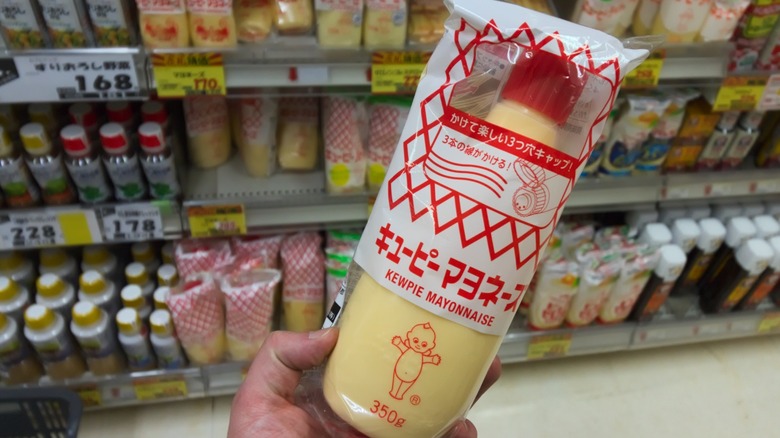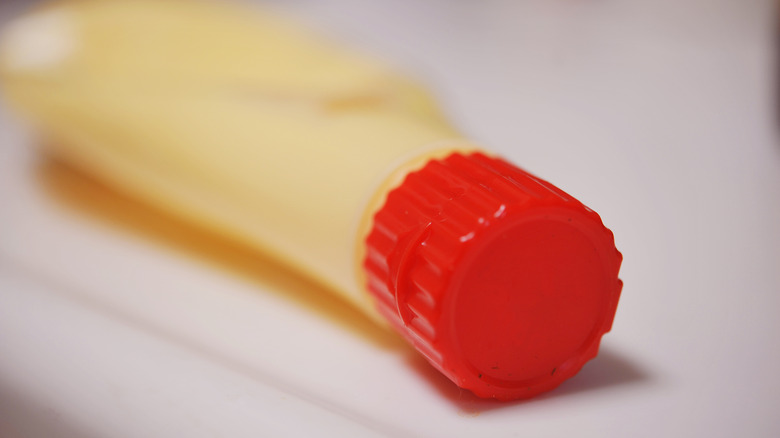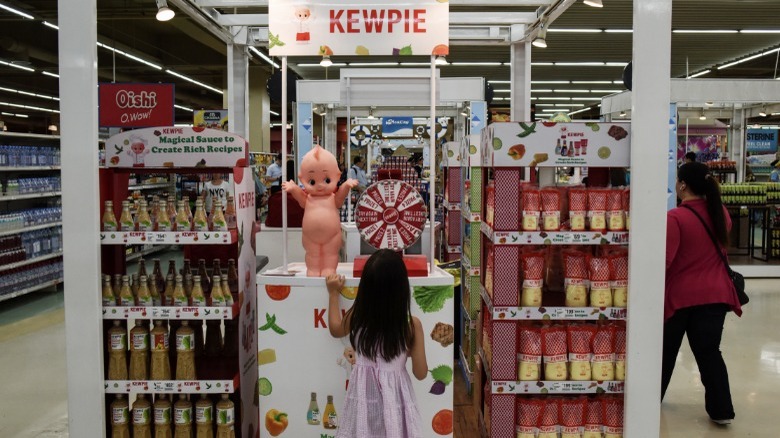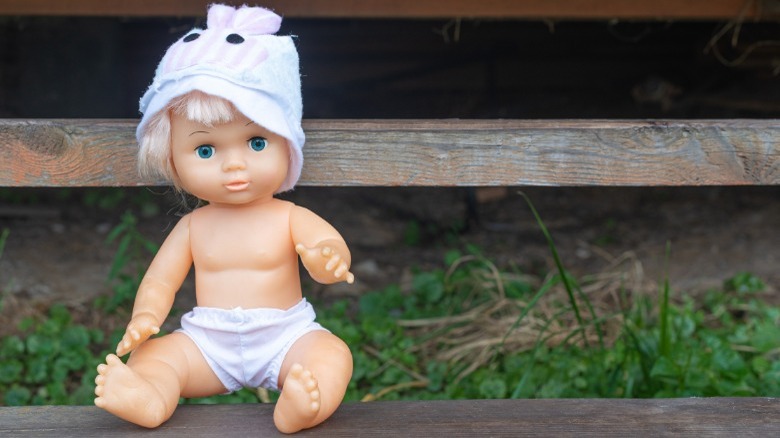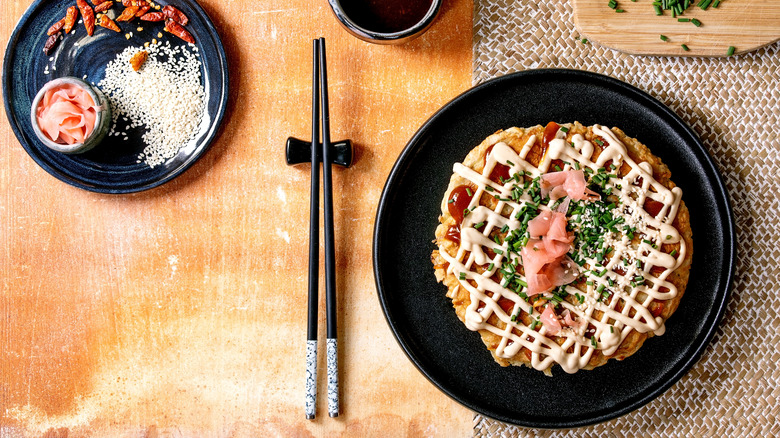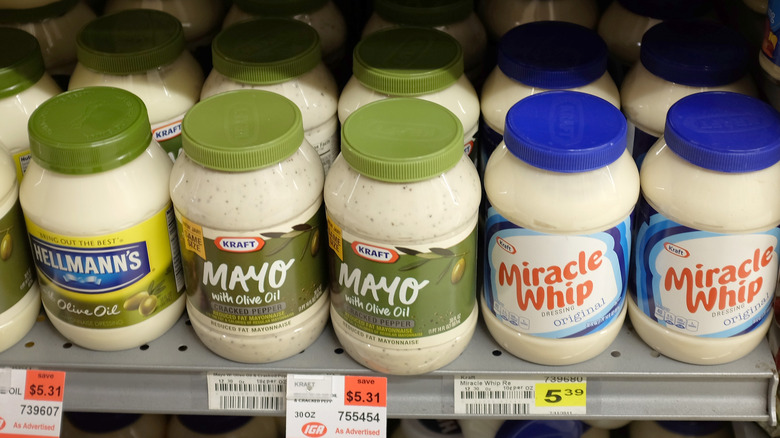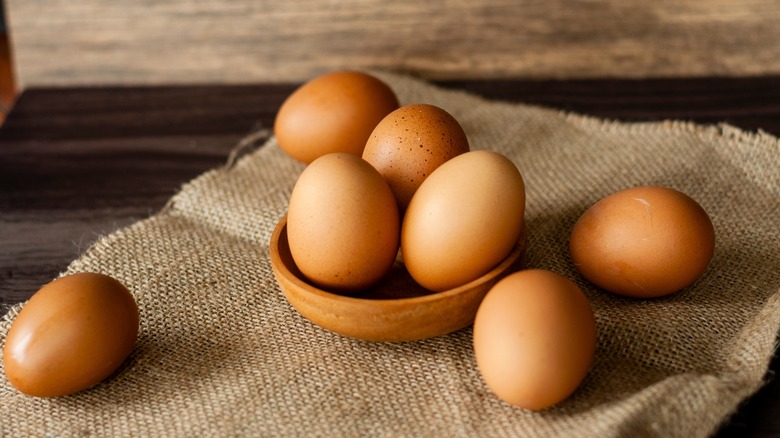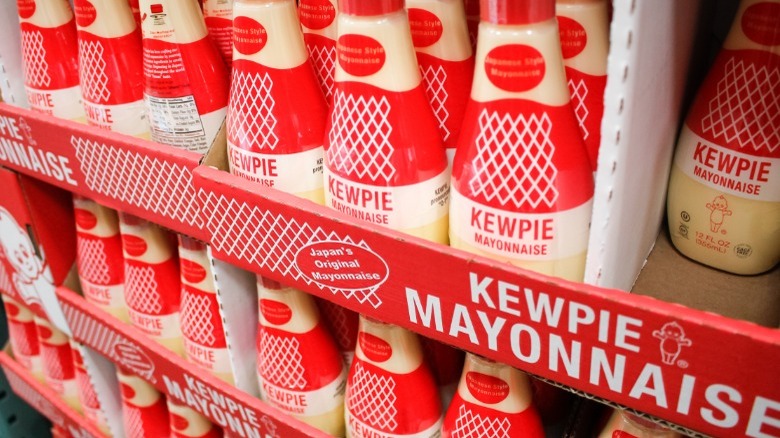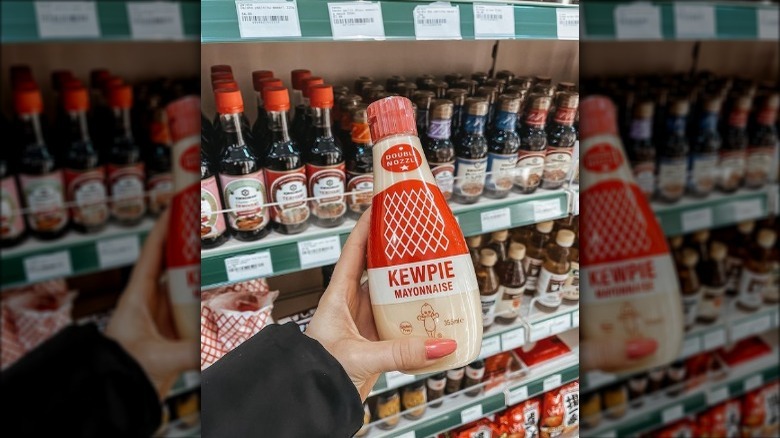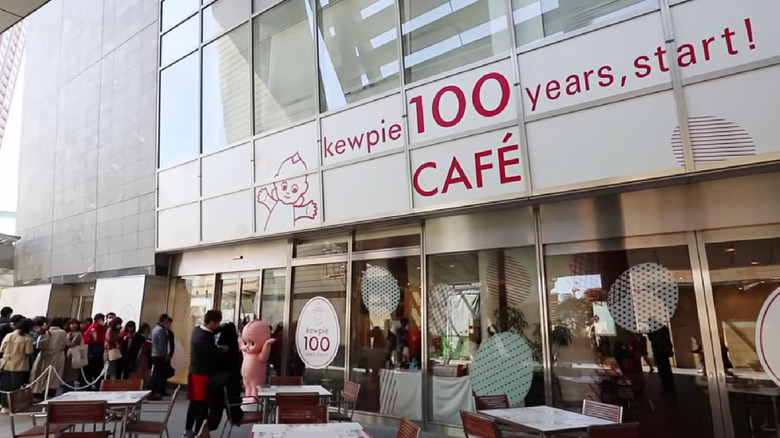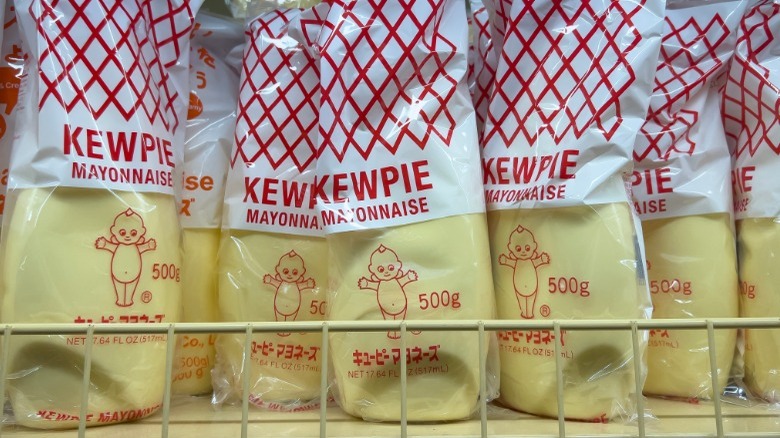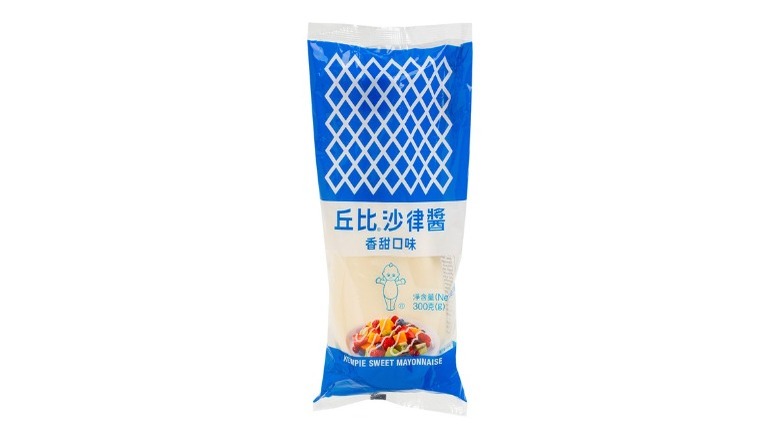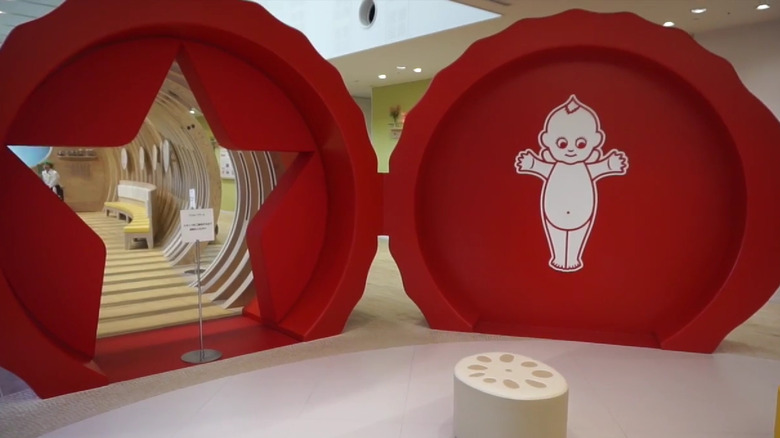The Ultimate Guide To Kewpie Mayonnaise
Condiments play a hugely important role when it comes to all global cuisines; historical and present. Ancient Romans favored garum – a fermented fish sauce — the Imperial Chinese invented ketchup, and Ancient Indians and Sumerians made mustard. So, what is it about these flavorful sauces that humans have not been able to get enough of? The International Journal of Gastronomy and Food Science reports that there are multiple answers to that question. The appeal of condiments is multifaceted, including flavor, appearance, texture, and general psychological appeal.
This psychological aspect has also seen modern day condiment brands achieve worldwide fame. Among these is Kewpie, a Japanese mayonnaise brand that has taken the world by storm. Having been praised by prominent chefs such as David Chang and Dino Tsaknis of Chicago's Primehouse (via Salon), plus Mason Hereford of New Orleans' Turkey and the Wolf, Kewpie is often seen as the king of mayonnaises. But what has taken this condiment to such dizzying heights? And is it really that different from other brands of mayonnaise? Read on to discover everything you need to know about one of the world's most adored condiments.
Kewpie's founder was inspired by his time in the United States
Before Toichiro Nakashima became a director at food manufacturing company, Shokuhin Kogyo Co., Ltd in 1919, he worked in both the United Kingdom and the United States for the Japan Department of Agriculture and Commerce (via Kewpie). It is safe to assume that during the three years he spent in these countries, Nakashima was exposed to many facets of Western culture. The one that changed his life was the Western obsession with a condiment known as mayonnaise.
Slate reports that mayonnaise – which used to be considered a luxury food — had been present in the United States since the first half of the 19th century. In the latter half, the condiment's popularity exploded as it was used in a range of dishes, namely salads. As a visitor to the United States in the early 20th century, Nakashima would likely have been unable to avoid mayonnaise. The exposure to the creamy condiment affected him so much that, upon arriving back in Japan, he was inspired to produce his very own version, albeit with several tweaks.
It was first made in 1925
Kewpie mayonnaise was launched in 1925, a time when American culture was beginning to influence the Japanese way of life. By all measures the mayonnaise was an incredible success. Kewpie reports that by 1941 — only 16 years after its initial launch — nearly 100,000 cases of the mayonnaise were being sold annually. This was an impressive feat given that it was the first condiment of its kind to be launched on Japanese soil.
During the 1940s, Japan began to suffer severe food shortages as a direct result of World War II. Shipping blockades and rail disruption exacerbated poor rice harvests, plunging millions of Japanese citizens and soldiers into famine and starvation (via National World War II Museum). Due to these widespread shortages, the production of Kewpie mayonnaise was stopped in 1943. Production only resumed when access to food products increased some five years later (per Kewpie).
The brand's logo is a Kewpie doll
Toichiro Nakashima was not only inspired by what Americans ate, but also by what captured their imagination. At the time of his visiting the United States, kewpie illustrations were all the rage. These cute baby-like characters were invented by feminist artist Rose O'Neill and first reached widespread acclaim in 1909, as per Smithsonian Magazine. Often used to advocate for women's rights, or to support racial equality, kewpie drawings soon morphed into kewpie dolls. The popularity of this toy was astounding, with dolls being sold in various countries around the world. Seeing the incredibly widespread appeal of kewpies, Nakashima decided to use them, which is why Kewpie mayo has a baby on its logo.
This choice has not been without its controversy. Japan Today reports that the cherubic-looking baby has been censored for bottles produced and distributed in the American market. Worries that the winged baby could be viewed as an angel fueled this decision, as this could alienate customers from religions which ban idol worship and iconography.
Kewpie is an example of yōshoku
As a country with a long trading history, Japan has seen all facets of its culture impacted by foreign influences. An example of this can be found in the country's food, where some Western influenced dishes have become an ingrained part of the public diet. These dishes, such as menchi-katsu, a deep-fried burger, are known as yōshoku and represent the meeting between Eastern and Western culinary practices, as per Tokyo Restaurants Guide.
Food products can also be classified as yōshoku, a fact that was exemplified by the rise of many Western food brands, such as Spam (via South China Morning Post), during the American occupation of Japan. Kewpie mayonnaise also forms a part of yōshoku because it perfectly demonstrates how Western-style products can be adapted for Japanese cuisine. Its use on many different Japanese dishes, from okonomiyaki to menchi-katsu, has only reinforced the feeling of yōshoku that surrounds the condiment.
Kewpie has more flavor than other mayonnaises
Yōshoku and clever branding have both played a part in the astronomic rise of Kewpie mayonnaise, but the main reason for Kewpie's popularity is simpler — the mayonnaise packs a lot of flavor. Unique and rich, the condiment has become an integral ingredient for home cooks and chefs around the world. Many sing its praises, including renowned chef Mari Katsumura: "The acid is a bit higher, it's a little sweeter and the umami content is a little stronger, as well. So I'd say, compared to Hellman's — Hellman's would be a five on a scale of one to 10 in terms of flavor, while Kewpie mayo is probably like a nine out of 10 in terms of flavor." (via Salon).
This isn't just simple brand bias. Kewpie has dominated other mayonnaise brands when it comes to blind tastings, such as one held by news outlet, the Chicago Tribune, and often featuring on lists of the best mayonnaise brands to buy. Upholding such high standards is not easy, especially when different versions of the mayonnaise are sold around the world. Through clever ingredient substitutions and other forms of problem solving, Kewpie manages this difficult task, ensuring all global consumers can enjoy the excellent flavor of Kewpie mayonnaise.
Ingredients are what make Kewpie superior
Mayonnaise is a simple condiment with few ingredients. One of the only ways brands can set their products apart is by focusing on unique processing methods and sourcing high-quality ingredients. Kewpie ensures that only the best produce is used for its mayonnaise by sourcing eggs from its very own egg corporation. The company has made a habit of inspecting all eggs for quality and freshness despite estimates that it uses 10% of all the eggs produced in Japan.
It isn't just ingredient quality that sets Kewpie mayonnaise apart, but also how the company uses them. Most notably, Kewpie only uses egg yolks in its flagship mayonnaise, while other brands use both the yolk and the white. By using four yolks per 500 gram product, Kewpie creates a mayonnaise that is unrivaled in its richness and flavor. This is something that has endeared it to chefs, cooks, and consumers across the globe.
Japanese and American Kewpie are different
We have already revealed that the branding of Japanese and American produced Kewpie mayonnaise is distinct. Interestingly, the differences don't stop there. Japanese-produced Kewpie mayonnaise contains manufactured monosodium glutamate which is commonly known by the acronym MSG. The American version however uses yeast extract instead. This may be due to manufactured MSG having an unsavory reputation in the United States — a prevalent stigmatization of an ingredient that has been proven to be safe for consumption, as per FiveThirtyEight.
The Chicago Tribune reports that yeast extract contains naturally-occurring MSG. However, the substitute is still noticeable, as reporter Joseph Hernandez explains: "The difference was almost immediately noticeable on texture. Whereas the Japanese version was creamy and almost earthy, the American one was just a touch unctuous. The original had a little more overall depth of savoriness (hello, MSG), while the American version was brighter, with more pronounced lemony-ness."
Allergens vary between American and Japanese versions of Kewpie mayonnaise
As the ingredients vary between the American and Japanese versions of Kewpie mayonnaise, it is only natural that there are some differences in allergen and dietary information as well. The mayonnaise produced in the United States is certified as being both kosher and gluten-free (per Kewpie), while the listed allergens include eggs, mustard flour, and vinegar, which can contain sulfites and cause a reaction (per Healthline).
In contrast, the Japanese Kewpie mayonnaise is not certified as kosher or gluten-free, but it does not contain mustard flour. Eggs and sulfites are still present (via Kewpie). These discrepancies, especially in mustard content, mean that those with dietary requirements due to personal choice, allergies, or faith, should always be sure to check the ingredients list. In other words, just because one Kewpie mayonnaise was suitable for you, does not mean they all will be.
It is incredibly popular in Japan
When Kewpie was forced to halt production due to war-related food shortages, there must have been some concern that the brand could struggle to regain its momentum. This was not the case. Kewpie has continued to grow over the decades and in 2021, total net sales for the brand were just over ¥400 billion (around $3.1 billion), as per Statista.
Sales are just one way to measure a food brand's popularity. In the increasingly popularized food sector, other indicators include whether a food brand has collaborations with other companies, such as clothes designers. Never a brand to miss a beat, Kewpie has adopted this trend by partnering with Uniqlo to create Kewpie branded t-shirts, as per Great Deals Singapore.
It is important to note that the brand owes the vast majority of its popularity to its culinary versatility. A fact explained by chef Mari Katsumura: "It's pretty prevalent all across the board. It's notoriously used for the egg salad sandwiches that you find in convenience stores everywhere in Japan. It's also a topping for okonomiyaki, the Japanese pancakes, and it's a topping for takoyaki, which are those little octopus balls that are common in Osaka. So it's a pretty versatile product." (via Salon).
There have been some Kewpie cafés
With such a wide and loyal fanbase, it was only a matter of time until Kewpie explored further business ventures. Cosmopolitan reports that this venture came in the form of some Kewpie-branded, mayonnaise-themed, pop-up cafés. Two cafés, one in Tokyo and one in Nagoya had a lifespan of one month each and were met with equal parts delight and dismay by the global public.
According to a press release by Kewpie, the dishes on offer at the cafés included mayo pizza, mayo pudding, and mayo chicken. The brand even advocates for a cooking technique labeled as the mayonnaise sauté, which involves frying ingredients with mayo. While you may be disappointed to learn that both cafés closed in 2017, Kewpie has made a habit of opening others for short periods as a way to celebrate the company's milestones. This included mayo cafés that were opened to celebrate the company's 100th birthday back in 2019, as per Kewpie.
The Kewpie bottle is an ingenious design
Innovation in bottle design seems to be a hallmark of the mayonnaise industry. Hellman's, another incredibly popular mayonnaise brand, made headlines when it won the 2015 Package of the Year award from The Association for Dressings & Sauces for a squeezy bottle that limited food waste. While Kewpie has not focused on freeing mayonnaise that used to be left behind in the bottle, the brand has still received recognition for its innovative packaging designs.
As Tensuke reveals, Kewpie's unique, multilayered plastic bottle helps slow down the oxidation process that ultimately spoils the product. Furthermore, the bottle features two different openings through which the mayonnaise can be squeezed — a narrow tip and a star-shaped tip. This allows consumers to accurately serve themselves the required amount of mayonnaise without overserving (is there such a thing as too much mayonnaise?). Outside of design, the company is also seeking to cut down on wastage by actively donating excess bottles of the mayonnaise to food banks, as per Kewpie.
Kewpie made a special mayo for China
Kewpie's original branding and recipe does not suit all international markets. However, the brand has proven itself to be both adaptable and willing to accommodate other culture's preferences. This was no better demonstrated than when Kewpie sought to break into the Chinese market.
According to Nikkei Asia, Kewpie initially launched the brand's original mayonnaise in China during 1993. The product had an underwhelming reception despite running several marketing campaigns. Upon reflection, the brand realized there was no demand for mayonnaise with the brand's traditional flavor profile. In response, Kewpie created a sweetened version that would complement the Chinese population's taste for dressed fruit salads. By adding sugar and a few other ingredients, Kewpie transformed the mayonnaise into something better suited for the Chinese population. The new product was an instant hit and has become so popular that further Kewpie factories are planned in China to meet demand, as per Nikkei Asia.
You can tour the Kewpie factory
If you've ever wanted to see 600 eggs cracked in under a minute, you need to book a trip to one of Kewpie's factories in Japan. On a tour, you can see a prodigious mayonnaise making production line in full swing, as per Visit Toyota City. The tours started way back in 1961 as a means of educating local primary school children. Today, the truth about Kewpie mayonnaise is that the tours across several factories attract around 100,000 guests per year. These tours are given the informal name "open kitchens," because the brand views its factories as just another part of a consumer's household kitchen.
One Tripadvisor reviewer noted that while the majority of the tour is only offered in Japanese — aside from an introductory video — there is a lot that non-Japanese speakers can still take from the experience. Most notably, a tasting experience where guests are given a variety of different mayonnaise flavors to try.
